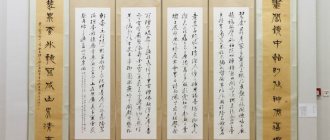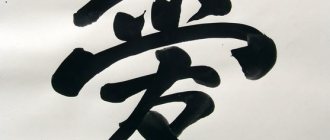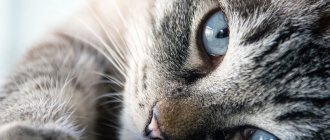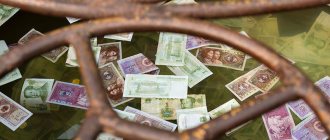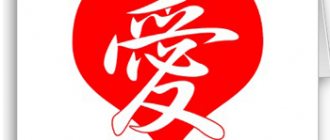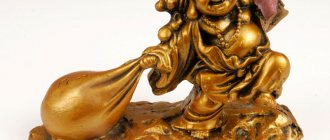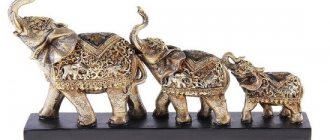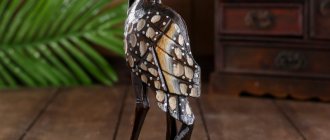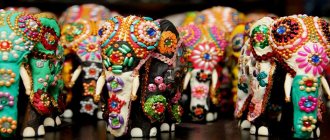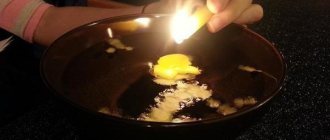Netsuke are cute talismans for all occasions, essentially Japanese miniature sculptures, often in a cartoon style. These can be figures of various deities, people and even animals. An interesting appearance made talismans popular not only among eastern peoples, but in our area.
We invite you to familiarize yourself with the whole variety of Japanese figurines and understand their meaning. Armed with new knowledge, you can choose a netsuke sculpture for yourself.
Three star elders
The elders, each of which has a specific meaning, are an antique set of products. The original figurines were made in the mid-20th century and are sold only in specialized “shops”. Their cost is quite high and it is difficult to find authentic copies.
Today, the production of porcelain sages has been put on stream; each master depicts the figurines differently, but what the elders symbolize remains unchanged. The idea is based on ancient Chinese astrology, namely, the three stars of the constellation called Carina, also called the Southern Dipper. And the triad is called San-sin .
Photo: Shou-sin, Fu-sin, Lu-sin
The red star Canopus, rising low from the horizon, is personified by the old man Shou-shin . The image has a long white beard and an elongated head. In one hand there is a paper scroll and a pumpkin, in the other a peach. In ancient paintings it is customary to depict a deer next to the deity, but on porcelain figurines it may not be there.
The Elder of the South Pole brings longevity, prosperity and a happy old age. The owner of the figurine must achieve good health. This symbol helps to heal deadly diseases.
Legend says that the image of this deity was created in the Northern Song Dynasty by the emperor, who connects one event from his life with this. One day he saw an old man on the street who needed help and took him to his palace. As a result, the emperor lived for a long time without knowing sadness or illness. Temples were even built in honor of Shou-shin.
Fu-hsing is notable for the bright red caftan worn by the sellers. He holds a baby in his arms. There is also a scroll in the composition.
The deity symbolizes wealth, prosperity and career success. In addition, the increase and health of offspring. If the owner of the deity figurine sincerely believes in the power of the talisman, then fate will turn out well.
There is a version that Fu-xing is a real person Yang Cheng from Daozhou (VI century), the mayor of a society of dwarfs. There was a problem in the city: every year the sovereign ordered people to be selected from the tribe in order to make jesters out of them. Yang Cheng, no longer willing to endure the separation of the families of his townspeople, managed to convince the sovereign that the outrages should stop.
Since then, the influential and courageous official, who was not afraid for his position and put human values first, has been deified as a stellar spirit, helping in career matters. There are many more legends, but this is the most common.
The third elder Lu-sin can be depicted in two forms: with a scroll and a scepter, or with a baby in his arms. The presence of a child or several children in a deity symbolizes the continuation of the family, worthy and caring heirs. An old man with a scroll helps its owner in gaining power.
The figurines can be purchased separately, but since ancient times, in folk culture, it has been customary to keep them together. The triad will attract happiness with increased power.
There is no need to install talismans in a specific place; you can “settle” them in any corner of the house. To ask for help, you only need to believe in the fantastic power of stellar spirits; you don’t need to utter special words.
Types of figures
From the very beginning, the figures differed in form and typology. In this regard, the following types can be distinguished:
- Anabori. Figures made from shells, inside of which a certain storyline is built.
Anabori - Itaruku. A distinctive feature of these symbols is that they were not carved like all netsuke, but were woven from wire or reed and formed the shape of a pumpkin or square. Itaruku
- Kagamibuta. They look like a flat vessel with a metal lid.
Kagamibuta - Katabori. This is the most popular and ancient type of netsuke; this includes figures of people and animals.
Katabori - Manju. This embodiment of Japanese art has a round shape and is made of elephant bone.
Manju - Ryusa - figurines with through carvings.
Ryusa - Sasi. The trophy is a block with a hole for a cord. With its help, keys, wallets and other necessary little things were attached to clothes.
Sasi
Seven images of Buddha
In modern Feng Shui, the worship of the gods of happiness is actively practiced. The talisman of the sage Hotei can be seen in many homes. There are seven traditional Buddha statues, each of which has a specific meaning.
The Laughing Buddha, or god Hotei , is a pot-bellied man with a bald head. There is always a smile on your face and a bag in your hands. Figurines of any configuration have a general and main meaning: they protect the house from negative (negative) energy.
- Classic version with a burden in your hands : coins attract wealth to the house, a pearl helps to gain wisdom, a staff protects against diseases, and a pumpkin brings prosperity.
- Surrounded by children . Symbolizes healthy and numerous offspring. Should be located in the living room.
- A peach in the hands of the god of happiness brings excellent health to the inhabitants of the house, longevity and the acquisition of stamina.
- If Buddha holds a fan , the owner of the talisman can count on the help of the spirit in successfully completing old affairs and starting new ones.
- The God of Happiness with an umbrella will protect you from accidents, blows of fate, and any tragic events that life brings.
- If the deity is riding a dragon , it symbolizes good luck in financial matters.
- Buddha sits on a hill with coins . This interpretation is the most popular in Feng Shui, because the meaning of the composition is to attract a lot of money.
In order for the magical figurine to help make your dreams come true, you need to rub the deity’s belly 300 times clockwise. At this time, you need to clearly formulate your desire.
What are netsuke made from?
A real netsuke figurine should be made only from natural material.
The Japanese use bone or wood as material, but you can also find porcelain, clay or ceramic figurines. Most often they are made in small sizes - only 3-4 cm in height. Sometimes larger specimens are also found.
Netsuke made of plastic is an incorrect figure. Artificial material has no connection with natural forces, which means it does not have the necessary energy. Such an accessory is nothing more than a simple detail in creating a themed interior.
Other Sages
In addition to the above, several more sages are traditionally issued, which also have a certain meaning.
Two gods of happiness Daikoku and Ebisu . They are made standing inseparably next to each other. Daikoku carries a bag of heavenly rice, a hammer and a rat. The rodent is not at all a bad symbol, but on the contrary, it is considered a friend of man; in this story, it accompanies the old man in order to gnaw at the bag and sprinkle rice, thus enriched with happiness, into everyone’s palm.
Ebisu is holding in his hand the Tai fish, known in Chinese mythology, which is a symbol of spirituality and promotes the self-development of thinkers.
The sages have an interesting meaning - the union of two friendly sages personifies the balance between the abundance of money, power, fame, and spiritual purity.
The deities are also made separately , in this case one symbolizes wealth, and the other spiritual well-being and happiness.
Hearthkeeper Zaoshen . The sage holds objects that together represent happiness in family life, protection and strengthening of the home. Has a tablet on which you can write down requests when you need the help of a deity.
There is a beautiful legend that explains how the old man makes the wishes of the owners of the talisman come true. Once a year, the sage goes to the very ruler of the Celestial Empire, to the sacred mountain Kun Lun. Namely, this happens on a significant date—December 24. At the reception, Zaoshen tells what useful things he has done for the family he protects, and hands over a sign with wishes. Thanks to this, dreams come true.
An equally interesting character is the god of immortality Jurojin . The amulet promotes a long life full of happiness. In his hands is majestically placed a scroll on which is written “Heaven grants immortality.”
And also, a musical instrument, when played on which, with the human appearance and body, a process is carried out that everyone dreams of - rejuvenation.
The sage Fukurokuju is the patron saint of scientists, helps in solving mental problems, obtaining education and any activities related to science. The old man is difficult to confuse with others; he has an elongated skull, symbolizing the presence of a non-standard, rich mind.
And in the forehead, large wrinkles are literally squeezed out, one glance at which is enough to immediately understand that this old man is distinguished by special wisdom. The staff completes the image.
Bishamonten, patron of warriors . Depicted in military uniform and with weapons. Promotes the acquisition of a combination of the following qualities: courage, fortitude and wisdom. It also helps to understand how to act fairly.
Objects and animals
Netsuke can depict not only deities and holy sages. These can be mascot objects or animals, mushrooms and snails.
| Name | Meaning |
| Toad with a coin | The three-legged toad that spits out gold coins is the most famous money magnet in feng shui. If you stroke it every day, you will certainly gain more wealth. Once she rebelled against Buddha, and was punished for her sins - now she must help everyone and give out money. |
| Whale | This is one of the three whales on which the earth stands, so meeting it promises good luck. Especially when traveling, and especially when traveling at sea: if you go on a cruise, be sure to take such a figurine with you. |
| Coin with a hole | Everything is clear here - money is money. Only such a talisman should not be worn around the neck, but kept according to Feng Shui in the zone that is responsible for material well-being. Better together with a money toad and some deity of wealth. |
| Monkey | The monkey is an ancient symbol of intelligence, dexterity and cunning. She always figures out how best to protect her ward from evil. |
| Bull | The bull is a symbol of strength, fertility and wealth. It is given to men. |
| Golden carp | Even in Japan, goldfish, that is, carp, is a symbol of abundance, happiness and fulfillment of desires. |
| Two carp | Everything is the same, only doubly for happy spouses. |
| Snake | It personifies not only wisdom, but also female beauty, as well as everything mysterious, unidentified and mystical. A symbol of the eternal cycle of energy and renewal of everything. |
| Elephant | An elephant, according to Eastern beliefs, is capable of ensuring the successful conception of a new life, so this talisman is usually placed at the head of the marital bed. |
| Ship | In the waves of the sea of life he is able to keep his family and the whole house afloat. |
| Pair of hippos | Another image of family happiness. It is believed that if a quarrel suddenly occurs between spouses, it is these hippos that will help to reconcile. |
| Eagle | A talisman for a leader, a symbol of a successful career and professional growth. A great gift for those who build their own lives and prefer to strive higher and higher. |
| Turtle | A common motif for netsuke is various turtles. The turtle is longevity and wisdom. If an eagle is depicted on a turtle, then this is a symbol of long and stable power. |
Lady deities
There are also female deities in Chinese mythology. They are presented in five images, each of which is endowed with deep meaning.
Goddesses - patroness of Chinese girls
Moon Fairy Ame no Uzume . Helps in finding true, eternal love, which makes a person happy and brings joy. It is also believed that it was thanks to her that theatrical art appeared and ritual dances were created. The goddess of love is depicted with a plump, kind face and long hair.
Mother of the West - Sivanmu , the immortal queen of heaven. Symbolizes love and health. Protects against accidents on the water.
According to legend, in the Kunlun Mountains the goddess kept a garden planted with miracle trees, and peaches grew on them. The fruit, already known in Chinese mythology, could heal hopelessly ill people and make a person immortal. The trees bore fruit once every thousand years, the goddess collected the harvest and prepared medicine from it.
Goddess Benzaiten helps girls find love, get married successfully and live a happy, prosperous life. The lady is also a symbol of art; a musical instrument and a snake woven into her hairstyle are added to her image.
Guanyin is the patroness of women in labor, pregnant women and people in distress. In addition, it is designed to help children. Her name translates as “hearing everything in the world.”
On the talismans, the goddess holds in her hands (always ready) a large thick book, a container (jug) with water, a powerful staff and a rope. It is generally accepted that symbols help save people from trouble in various situations.
According to legend, when urgent help is needed, a woman activates thousands of hands, and eyes appear on her open palms, thus helping everyone in need.
Amaterasu , chief among the gods of happiness. The goddess is a symbol of a real woman, who must combine the following qualities: unearthly beauty, great and deep wisdom, virgin purity and harmony. The owner of the statue receives help in striving for the ideal.
History of the appearance of figures
This art appeared around the 16th-17th centuries, but gained mass popularity in the 19th century - at this time changes occurred in the interpretation of the images of figurines. The military government of Japan adopted a policy of preserving the created structure of society: several laws were passed against luxury. There is a strict distinction between classes. This is reflected in literally everything: lifestyle, the number of floors in the house, the material from which clothes are made.
In such conditions, the townspeople did not have many opportunities to decorate their costumes: netsuke were one of the ways to demonstrate their own taste. Using them you can study the peculiarities of the life of the Japanese, their clothing and the natural features of the country. Initially, netsuke served only as key rings for attaching keys and other things - Japanese national clothing did not have pockets.
Later, people discovered that the figurines were endowed with magical powers. They bring love, freedom and happiness. So netsuke became real talismans for people, the popularity of which is only growing every day. They are purchased as souvenirs - for themselves and as gifts for friends.
Gradually, entire schools of netsuke carvers arose; each of them had their own style and favorite themes. For example, the Hida school made figures in the Ittobori style. Only one knife was used for the job; small parts were not carefully processed.
The history of the development of this amazing type of Japanese art is widely reflected in museum collections around the world. An Association has even been created, which includes both netsuke-making specialists and ordinary people who are interested in Japanese culture. At community congresses, experience is exchanged and new technologies for netsuke manufacturing are mastered.
REFERENCE! The largest collection of netsuke was collected by the American Robert Kinsei.
People
In addition to scenes of everyday life, there were images of people, most often actors, holding masks in their hands for a theatrical performance. A real masterpiece are figures with moving parts, it seems that the actor is putting on and taking off a mask. Equally common are images of arhats, ascetics who have reached the highest level of spirituality and personal development. They lead a restrained life and are examples of moral purity. They are depicted with begging bowls, from which a dragon may look out, as a symbol of restraint and fortitude. These figures help people achieve heights in self-improvement.
Netsuke "Ebisu with big fish"
0
See all photos in the gallery
Size 45/40 mm Material ivory Meiji period
Since ancient times, people have worshiped idols - wooden and stone images of gods who patronized hunting and fishing, protected the hearth, livestock and children. Gradually, the worldview changed, but in some religions miniature images of deities have been preserved, which bring various benefits to believers: good luck, happiness, money, health, love. Objects for worship can be images of people, birds, animals, mythical creatures, as well as objects of inanimate nature.
Mythical characters
The most popular figure - the dragon - bestows prosperity, power and wealth. The dragon is one of the most powerful figures in Feng Shui philosophy; it must be positioned correctly so that it feels important. Tengu is a celestial dog, the patron of night travelers and roads. It is believed that Tengu does not like to communicate with ordinary people, but can protect them from afar. He is depicted in two versions: Notamago-Tengu - bird-shaped and Karasu-Tengu - human-shaped. Baku is a mythical creature resembling a tapir with an elephant trunk, tiger paws and a bull tail. It can cure nightmares, improve mood, calm nerves, and drive away demons that torment a person from the inside.
